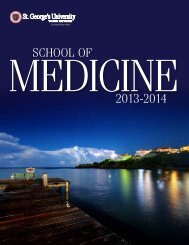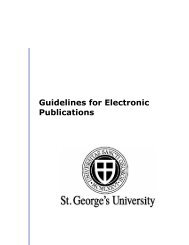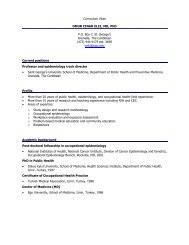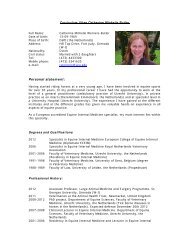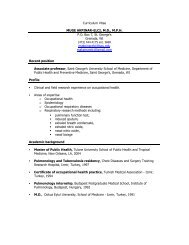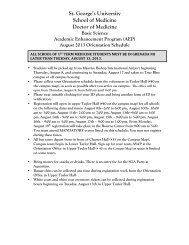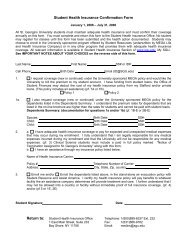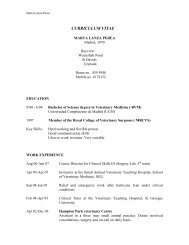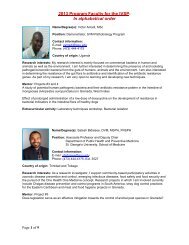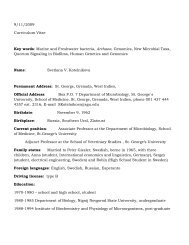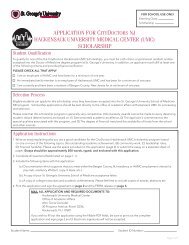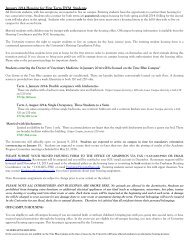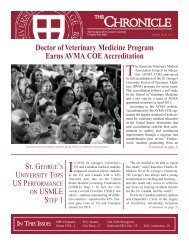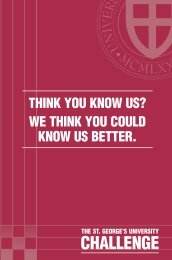SVM Catalogue 2012-2013 - St. George's University
SVM Catalogue 2012-2013 - St. George's University
SVM Catalogue 2012-2013 - St. George's University
Create successful ePaper yourself
Turn your PDF publications into a flip-book with our unique Google optimized e-Paper software.
and business finance, and personal/business management<br />
skills. <strong>St</strong>udents are given an understanding of the breadth<br />
of veterinary medicine, career opportunities, and other<br />
important information about the veterinary profession. In<br />
small-group presentation format, students strengthen<br />
communication skills by presenting and debating ethical<br />
issues in veterinary medicine.<br />
PTHB 531<br />
Laboratory Diagnostics<br />
(1 cr.) (Clinical Rotation) This offers students experience in<br />
practical necropsy and clinical laboratory skills in clinical<br />
pathology, microbiology, and parasitology laboratory<br />
rotations.<br />
Necropsy Section: <strong>St</strong>udents perform a complete necropsy,<br />
recognize and interpret gross lesions in a disease process,<br />
and prepare a written necropsy report. Emphasis is<br />
placed on collection and submission of specimens to a<br />
laboratory for histopathology and for microbiology and<br />
toxicology if relevant. <strong>St</strong>udents correlate gross necropsy<br />
and microscopic findings to make an appropriate diagnosis.<br />
Safety precautions with respect to equipment, protective<br />
wear, and biosecurity are introduced.<br />
Clinical Pathology Section: <strong>St</strong>udents practice laboratory<br />
safety procedures, perform a complete manual blood<br />
count, urinalysis, and biochemistry analysis using an<br />
Idexx VetTest®. <strong>St</strong>udents are expected to demonstrate<br />
basic competence in the preparation and examination of<br />
cytological specimens. <strong>St</strong>udents shall be able to select/<br />
provide the correct test(s) for a wide variety of diseases<br />
of domestic animals, be able to submit the appropriate<br />
sample for these tests, and have the ability to accurately<br />
interpret a series of laboratory results in the content of<br />
patient history and clinical signs.<br />
Parasitology Section: <strong>St</strong>udents identify common parasites<br />
in feces, blood, urine, skin, and body fluids. Emphasis is<br />
placed on clinical cases where students are expected<br />
to make a diagnosis based on history, clinical signs, and<br />
identification of the parasite(s), as well as recommend<br />
treatment and control strategies based on the diagnosis.<br />
SAMS 524<br />
Small Animal Medicine II<br />
(3 cr.) (Didactic) <strong>St</strong>udents are introduced to concepts<br />
concerning the diagnosis, treatment, and management<br />
of medical diseases in dogs and cats. Emphasis is placed<br />
on cardiology, respiratory, neurological, oncological,<br />
endocrine, and gastrointestinal diseases, and emergency<br />
and critical care medicine.<br />
SAMS 528<br />
Small Animal Clinical Services<br />
(1 cr.) (Clinical Rotation) The objective of the course is to<br />
prepare Term 6 students for Year 4 Clinical <strong>St</strong>udies at<br />
affiliated universities using clinical case material presented<br />
at the SGU Small Animal Clinic. Through supervised handson<br />
training, students are directly involved in history taking,<br />
patient physical examination, and formulation of diagnostic<br />
and therapeutic plans for outpatient and critical care cases.<br />
Under faculty supervision, students are responsible for<br />
presurgical physical examination and diagnostic workup,<br />
postoperative care, and completion of all surgery-related<br />
documents (surgical report, anesthesia record, discharge<br />
instructions). Surgical students participate in surgical cases<br />
in the roles of primary surgeon, assistant surgeon, and<br />
anesthetist. <strong>St</strong>udents practice interpretation of clinical<br />
radiography. Intensive case management and medical<br />
recordkeeping for in-house small animal patients is<br />
required, along with client communication and daily case/<br />
rounds presentations.<br />
Year 3: Term 6 Selective Courses<br />
Year 3, Term 6 students are offered a variety of specialty<br />
courses to augment the core curriculum. Sixth-term<br />
students select two of the following one-credit courses for<br />
their final semester of preclinical course work.<br />
ANPH 521<br />
Client Grief in Veterinary Medicine<br />
(1 cr.) (Didactic and Other) Topics related to veterinary client<br />
grief will be covered using lecture, case presentations and<br />
small-group role play. Course topics include relationships<br />
between animals and people, grief, client communication<br />
skills, animal euthanasia, after care, and veterinary staff<br />
support.<br />
PTHB 533<br />
Advanced Clinical Exotic Pet Medicine and Surgery<br />
(1 cr.) (Didactic) This course provides students with an<br />
interest in alternative species medicine an in-depth<br />
exploration of exotic animal medicine and surgery<br />
practiced today. <strong>St</strong>udents gain comfort with the clinical<br />
approach and equipment necessary for diagnosis,<br />
School of Medicine<br />
Course Descriptions<br />
School of Veterinary Medicine Catalog <strong>2013</strong>–2014 | 55



